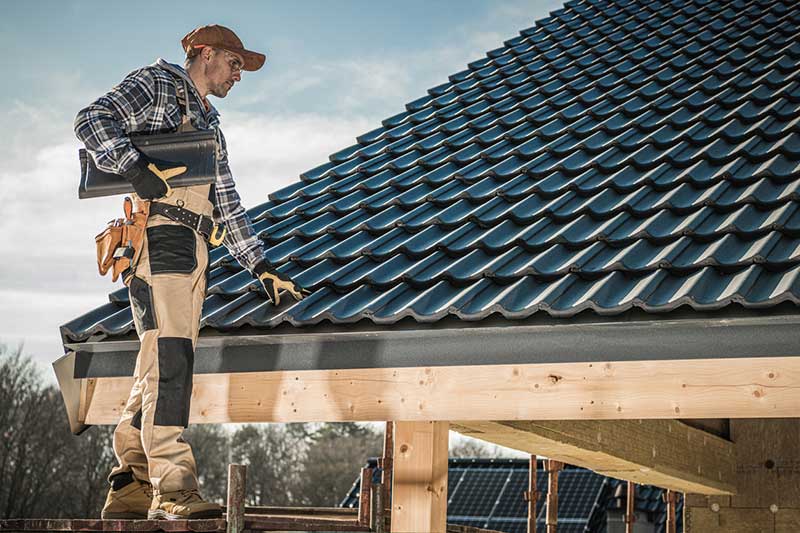A roof collapse is a frightening and potentially dangerous situation that can result from various factors, such as heavy snow, ice, severe storms, or structural issues. While it’s a rare occurrence, knowing how to respond to a roof collapse is crucial for your safety and the well-being of your home. In this blog, we’ll guide you through the essential steps to take if you find yourself facing an emergency roofing situation.
1. Prioritize Safety:
Safety should be your top concern in the event of a roof collapse. Follow these immediate safety measures:
- Evacuate Safely: If you are inside the house when the roof collapses, get out as quickly and safely as possible. Do not linger inside the building.
- Avoid Entering: After a roof collapse, do not re-enter the building until it has been declared safe by a qualified professional. The structure may be unstable, and there could be hidden hazards.
- Turn Off Utilities: If it is safe to do so, turn off the gas, water, and electricity in the affected area to prevent further damage or potential hazards.
2. Call for Help:
Once you are safely outside the building, call for emergency assistance:
- Dial 911: If there are any injuries or if you suspect someone might be trapped inside, call 911 immediately.
- Contact a Roofer: After ensuring everyone’s safety, contact a professional roofing contractor with experience in emergency roof repairs. Explain the situation, and they will guide you on the next steps.
3. Document the Damage:
While waiting for emergency responders and roofing professionals, document the damage as thoroughly as possible:
- Take Photos and Videos: Use your smartphone or camera to capture images and videos of the collapsed roof from a safe distance. These visuals will be valuable for insurance claims and assessments.
4. Stay Away from the Damaged Area:
It’s crucial to avoid the area directly beneath the collapsed roof or any sagging portions. Even minor movements could further destabilize the structure.
5. Protect Your Property:
Take steps to minimize further damage to your home:
- Cover Openings: If possible, use tarps or other materials to cover any openings created by the collapse to prevent rain or debris from entering the building.
- Remove Valuables: If there are valuable or irreplaceable items in the affected area, remove them once it’s safe to do so.
6. Insurance and Documentation:
Contact your homeowner’s insurance company as soon as possible to report the roof collapse. Provide them with the information and documentation you’ve collected. Be prepared to answer any questions they may have about the incident.
7. Assess the Cause:
Determining the cause of the roof collapse is essential:
- Natural Disasters: If the collapse was due to heavy snow, ice, or severe weather, your insurance may cover the damages. Document the weather conditions and any warnings issued.
- Structural Issues: If the collapse resulted from underlying structural problems, your insurance claim might depend on the specifics of your policy and the cause of the damage.
8. Temporary Repairs:
While you await professional assistance, your roofing contractor may recommend temporary measures to prevent further damage or water intrusion:
- Tarping: Experienced professionals can tarp over the affected area to provide immediate protection from the elements.
9. Plan for Long-Term Repairs:
Once your safety has been ensured, and temporary measures have been taken, you’ll need to plan for long-term roof repair or replacement:
- Consult Roofing Professionals: Work closely with your roofing contractor to assess the extent of the damage and discuss the best course of action for repair or replacement.
- Obtain Multiple Quotes: If necessary, obtain quotes from multiple roofing contractors to ensure that you receive a fair assessment of the repair or replacement costs.
10. Preventative Measures:
After your roof has been repaired or replaced, consider taking preventative measures to reduce the risk of future roof collapses:
- Regular Inspections: Schedule regular inspections by a professional roofing contractor to identify and address any structural or maintenance issues before they become major problems.
- Snow Removal: If you live in an area prone to heavy snowfall, consider professional snow removal services to reduce the load on your roof during severe winter weather.
In conclusion, a roof collapse is a stressful and potentially dangerous situation that requires immediate action. Your safety should be the top priority, followed by contacting professionals to assess the damage and plan for repairs or replacement. Remember that roofing emergencies can be complex, and DIY repairs are strongly discouraged. By following these steps and working closely with experienced roofing professionals and your insurance company, you can navigate the challenges of a roof collapse and restore the safety and integrity of your home.
Oceanside Roofing Company https://www.oceansideroofingcompany.com/

